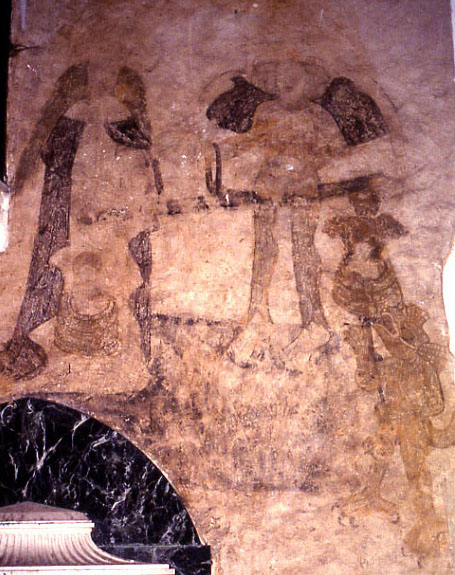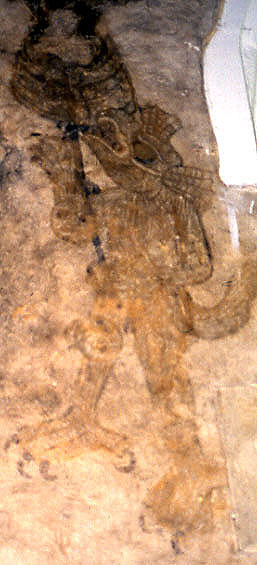Bartlow, Cambridgeshire (†Ely) C.15
Weighing of Souls

Of the three paintings remaining at Bartlow, this is the least sophisticated, with a rather stiff articulation of the main figures, but it is also the most complete and the most interesting.
The detail is very hard to see, even on the wall, but the Virgin on the left extends her right hand from beneath her mantle to rest it on the bar of the balance, which has two basket-like pans suspended from it. Baskets like these, woven from reeds, would in all likelihood have been used for weighing commodities, especially in the Cambridgeshire fens.
Further right, St Michael, holding the balance by its large central ring, probably owes much of his appearance to the medieval stage. His feet are bare, but as at South Leigh the feathered leggings he wears have come straight from a medieval players’ property list.

Most remarkable of all here though is the devil at the lower right, who wields a long hooked pole in an attempt to pull down the counterbalancing basket, thus competing directly with the Virgin for the soul (photo, left). Much care and ingenuity has been lavished on the fantastic appearance of this devil, who is a composite of various animal characteristics.
A lizard-like head has a crest and two finny protruberances probably intended for ears. What seems to be an eye is huge, and despite the generally reptilian aspect, the mouth gapes like a bird’s beak – the Hell-mouth at Great Harrowden is broadly similar. The claws, especially on the gigantic feet, have also come from a bird, and a final imaginative touch is provided by a fox’s brush as a tail.
For most medieval people, the theology behind these intentionally repellent physiognomies would have its source in contemporary drama. In the Tanners’ Play of the Creation from the York Mystery Cycle, Lucifer relishes his original glorious appearance – “I am favoured and fair and figured full fit/The form of all fairness upon me is fast…” But after his challenge to God and the consequent Fall of the Rebel Angels, all is changed: “Now I am loathliest, alas, that ere was so light/My brightness is blackest of hue now¹… Thus does the epitome of perfection that was Lucifer become the extreme of imperfection, best understood by medieval countryfolk as a monstrously unnatural mixture of different elements – birds’ feet, a newt’s head, a fox’s tail. And the ‘lower’ the animal – the frog, the toad, the newt – the more appropriate.²
The other paintings at Bartlow – the head and shoulders of a very fine but very late St Christopher, and a fragment of a St George and the Dragon, will be here in due course.
¹ The York Cycle of Mystery Plays: The Tannours, JS Purvis, SPCK, 1957, p.17, 18
² It was believed throughout the Middle Ages and beyond that such creatures were spontaneously generated in the mud of their habitat.